|
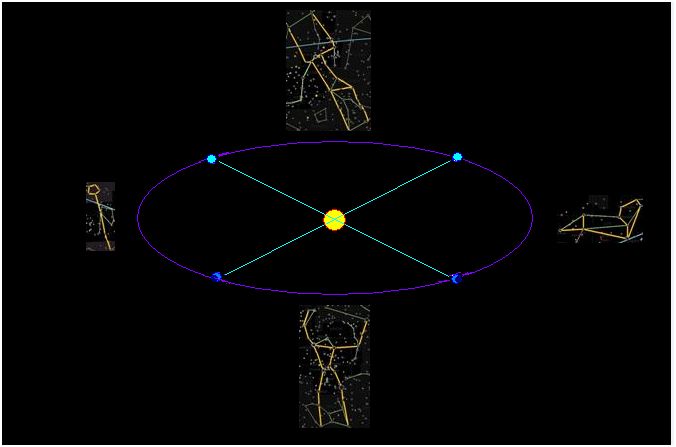
Standing upon
the earth, not all the proposed constellations that spell out the name of
the Eternal can be seen at once in
the starry heaven. But as our spinning planet cycles through her seasons in
orbit around the sun, the symbols appear in order in the night sky. The
stars spell out the divine name in an endless round – as if earth’s
firmament were an enormous, perpetual prayer wheel.
Ha Shem (The
Name)
The sacred name of the Hebrew God is called
“the Tetragrammaton” because,
spelled out, unabbreviated, the name consists of four symbols.
First is the Hebrew letter yod
י (which means hand).
Yod is the tenth letter of the Hebrew aleph-bet. Anciently, yod was
represented by a hand, or forearm hieroglyph - like this
 . .
Second is the Hebrew letter hey
ה, as in the spelling of “Halelu-Yah”
– a well
known, but perhaps less often understood Hebrew expression meaning “Praise you
(plural) the
Eternal”.
(Tehilim (Ps.) 135:1) Hey is the fifth letter of the Hebrew aleph-bet and was
long ago represented by a hieroglyph depicting a person with upraised arms
 . .
Third is the Hebrew letter vav
ו (which means nail, hook, or peg  ). Vavim held the weight of the veil of the
ancient tabernacle or portable temple of
Yisra’El
(Israel) in the wilderness. The veil was hung in the colors of blood and bruising. (Shemot
(Ex.)
26:31-32,
Hebrews 10:19-20) ). Vavim held the weight of the veil of the
ancient tabernacle or portable temple of
Yisra’El
(Israel) in the wilderness. The veil was hung in the colors of blood and bruising. (Shemot
(Ex.)
26:31-32,
Hebrews 10:19-20)
Some Hebrew scholars suppose that the vav, in the divine name, does not
make a “v” sound. Vav can make the sound of “ō” or “ū”.
It is argued that the “vav”
in the sacred name could have been pronounced “ō”, “ū” or “w”.
The sacred name ends with a second hey
ה =  . .
Ah, but is this hey really the end?
Arranged in a circle, which has no beginning or end, the four symbols can be
read “ havah”, “the hand that
is (exists)”.
The symbols can also be interpreted to suggest “the hand of being (existence)”,“the hand of desire”,
“the hand that gives breath”, “the hand
of destruction”.
havah”, “the hand that
is (exists)”.
The symbols can also be interpreted to suggest “the hand of being (existence)”,“the hand of desire”,
“the hand that gives breath”, “the hand
of destruction”.
“Ha-yaho …” can also be read continuously on
the wheel! With the definite article (hey) in
front, the expression can be interpreted to mean “The one (he) who
will ever be …” This can be seen as a third person version of the first person
divine name that God revealed to Mosheh (Moses, Shemot (Ex.) 3:12-15). Alternately, the circular writing can be read,
“Hayah,
v’Hayah, v’Hayah …” endlessly, meaning “He was, and He
will be, and He will be …”
(Bereshit (Gen.)
2:10);
since “v’Hayah” is frequently interpreted to mean “and it
(he) shall be”, or “and it (he) came to pass”.
(Bereshit (Gen.) 6:21,
Yesha’Yahu (Is.)
7:21, Moses 7:35) Thus “…from everlasting to everlasting” appears to be implicit in the divine name. (Tehilim
(Ps.) 90:1-2;
135:13)
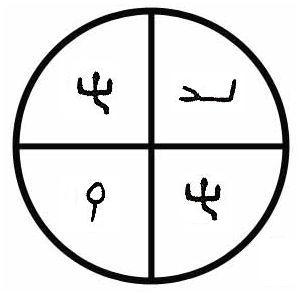
This is the name which God bestowed “in” his messenger who led his people in the wilderness,
the name with which his covenant people are endowed; the sacred name that is
put upon them.
(Shemot (Ex.) 23:20-21,
Bemidbar
(Num.) 6:26-27,
Yesha’Yahu (Is.) 56:3-5)

From right to left, in the ancient characters of a kind of phonetic, reformed Egyptian, the
hand of Salvation and Judgment
may be seen, followed by
persons with upraised arms, joined as by a
nail (i.e. made one by
covenant).
That the Eternal name may involve
separate and distinct persons, appears to be implicit
in the characters. The characters can also be interpreted to suggest the
hand of him (first hey) that was fastened with a nail, and who is risen (last hey).
(Yesha’Yahu (Is.) 26:19)
Consider the third verse of the first chapter of “Bereshit” which literally
means “in [a] beginning”, but which is commonly called “Genesis”.
(Bereshit (Gen.)
1:3) The line is translated to read, “And God said, Let there be light: and there was light.”
Transliterating the Hebrew verse we read, “Va-yomer Elohim,
Yehi or: va-yehi or.”
“Yehi” can be interpreted “He will be” (future tense); while “va-yehi”
can be
interpreted to mean “and he was” (past tense). The Hebrew letters spelling out the
combined expressions are as follows:
“יְהִי
וַיְהִי”
- the name of the creator(s) with three more hands.
A forth permutation of the symbols, seen in the circled cross, may be read: “Havah  ”.
This can be interpreted to mean “Become the hand”. See Bereshit (Gen.)
27:29. ”.
This can be interpreted to mean “Become the hand”. See Bereshit (Gen.)
27:29.
In regards to a shortened form of the divine name, Yah,
bestowed in the title of a messenger, “sent from the Celestial Kingdom”,
with “redeeming power”; and upon one delegated with “Kingly power ..
authorized to execute judgment for the King”, as “one next to supreme”,
consider the Ahmehstrahan terms “Jah-ni hah” and “Jah=ho=e=oop”.
(Grammar and Alphabet of the Egyptian Language (1835), pp.
24,
27,
29,
31,
and
33)
It should be clear that “Jah”, in these arcane
titles, intentionally relates to the theonym.
The “J” in such cases, might be a translator’s convention
- a substitution. There is really no “J” in Hebrew. Take a look
at Psalm 68:4 (KJV):
“Sing unto God [Heb. Elohim], sing praises to his name: extol him that rideth upon the heavens
[Heb. desert-plains, evening skies] by [Heb. in] his name JAH [Heb.
Yah], and rejoice before him.”
The Prophet Joseph Smith said:
“Were I an Egyptian [Ah meh strah an], I would exclaim Jah..[here the Prophet inserted a close imitation of
the Tetragrammaton!],
Enish-go-on-dosh, Flo-ees-Flos-is-is;
O earth!
the power of attraction, and the moon passing between her and the sun. A
Hebrew; Haueloheem yerau; a Greek, O theos phos esi; a Roman, Dominus regit
me; a German, Gott gebe uns das licht; a Portugee, Senhor Jesu Christo e
libordade; a Frenchman, Dieu defend le droit: but as I am, I give God the
glory, and say in the beautiful figure of the poet;
'Could we with ink the ocean fill;
Was the whole earth of parchment made;
And ev'ry single stick a quill;
And every man a scribe by trade
To write the love, of God above,
Would drain the ocean dry;
Nor could the whole upon a scroll,
Be spread from sky to sky.'”
(Times & Seasons,
November 1, 1843, pg. 373)
According to the Prophet, taking the point of view of an Ahmehstrahan, “Jah..[Tetragrammaton],
Enish-go-on-dosh, Flo-ees-Flos-is-is” translates, “O the
earth! the power of attraction, and the moon passing between her and
the sun.” The Prophet seems to be
telling us that the “Egyptians” (Ahmehstrahans) associated the sacred title
of deity with this planet.
Joseph Smith’s published statement correlates well with what his scribes (W.
W. Phelps and Warren Parish) recorded in the “Grammar
and Alphabet of the Egyptian [Ahmehstrahan]
Language” (1835).
In what follows, the Gentile term “planets” (a term Abram would not have
used) should be replaced with the biblical Hebrew term “mazalot” (stars of
fortune, abodes of gods). It’s
true that “mazalot” is translated “planets” in 2
Kings 23:5,
KJV, but “mazalot” may also
connote constellations (groups of stars) of a zodiac. (2 Kings 23:5, Brown-Driver-Briggs-Gesenius
Hebrew and English Lexicon, 4208,
מַזָלוֹת,
pg. 561)
The retrograde wanderers (the planets), and the relatively fixed and regular
zodiacal constellations, all seem to reside near the
ecliptic - the path
that the sun appears to take in the heavens, and that the moon periodically crosses. The expression “fixed planets”
found in Figure 5 of
Abraham Facsimile 2
ceases to be a Mormon oxymoron, when “planets” is understood to
be the Hebrew “mazalot”. The “fixed” mazalot in this case, are not
“wandering stars” (NT Greek “planetai”, e.g.
Jude 1:13) but are seemingly “fixed”
groups of stars seen moving together in the night sky – in the vicinity of
the ecliptic.
By the way, in copying Iyov
(Job) 38:32, a scribe long ago confused the
Hebrew letter lamed (ל)
in “mazalot” for a raysh (ר).
This is easy to do when copying a text written in post exilic Hebrew. The
letters can look alike! The
scribe mistakenly spelled “mazarot”, or “Mazzaroth”, as baffled King James
translators rendered it. (Brown-Driver-Briggs-Gesenius
Hebrew and English Lexicon, 4216,
מַזָרוֹת, pg. 561)
I believe that Joseph Smith’s Ahmehstrahans of Ptolemaic times, had unique insights into the afore mentioned verse in Iyov. I believe they studied Iyov
(Job) 38:31-33
closely.
Let us consider what the scribes of the Prophet Joseph Smith recorded on the
subject of the earth and planets [mazalot].
In what follows, symbols on the left (enlarged and formalized) accompany
explanations from the Joseph Smith
Egyptian Papers:
 “Jah..[Tetragrammaton]
The earth under the governing< powers> of oliblish, Enish go on dosh, and Kae-e van rash, which are the grand
governing
key or in other words, the governing power,
which governs the fifteen fixed stars <(twelve[illegible])>
that belong governs the earth, sun, &
moon, (which have their power <in> one,) with the other
twelve moving planets
[mazalot]
of this system. Oliblish=Enish go on dosh
[the sun as one of the governing mazalot; see
Abraham Facsimile 2, Figure 5 explanation],
and Kaii ven rash, are the three grand central stars
which powers that govern all the other creations, which have been
sought out by the most aged of all the fathers, since the beginning of the
creation, by means of the urim and Thummim:
The names of the other twelve of the fixed stars are: Kolob,
Limdi, Ziss, Vurel, Venisti, Waine, Wagah=ox=oan, oansli, Keble
Shineflis, flis, ots. The Egyptian
[Ahmehstrahan] names, of the fifteen moving
planets
[mazalot] are: Oan isis, Flos-isis, flo’ese: Abbesele, Ele ash, Sabble,
Slundlo, ear roam, Crash ma kraw, obbles isim, Izinsbah. Missel Nah
me,sile ohee oop Zah, Zaol.”
“Jah..[Tetragrammaton]
The earth under the governing< powers> of oliblish, Enish go on dosh, and Kae-e van rash, which are the grand
governing
key or in other words, the governing power,
which governs the fifteen fixed stars <(twelve[illegible])>
that belong governs the earth, sun, &
moon, (which have their power <in> one,) with the other
twelve moving planets
[mazalot]
of this system. Oliblish=Enish go on dosh
[the sun as one of the governing mazalot; see
Abraham Facsimile 2, Figure 5 explanation],
and Kaii ven rash, are the three grand central stars
which powers that govern all the other creations, which have been
sought out by the most aged of all the fathers, since the beginning of the
creation, by means of the urim and Thummim:
The names of the other twelve of the fixed stars are: Kolob,
Limdi, Ziss, Vurel, Venisti, Waine, Wagah=ox=oan, oansli, Keble
Shineflis, flis, ots. The Egyptian
[Ahmehstrahan] names, of the fifteen moving
planets
[mazalot] are: Oan isis, Flos-isis, flo’ese: Abbesele, Ele ash, Sabble,
Slundlo, ear roam, Crash ma kraw, obbles isim, Izinsbah. Missel Nah
me,sile ohee oop Zah, Zaol.”
(Grammar and Alphabet of the Egyptian
Language (1835), Second Part, 5th Degree,
pp. 24-25
 “Kolob.
signifies the first creation nearer to the celestial, or the residence of
God, first in government, the last pertaining to the measurement of
time, the measurement according to celestial time which signifies,
one day to a cubit which day is equal to a thousand years according to
the measurement of this earth or Jah..[Tetragrammaton]”
“Kolob.
signifies the first creation nearer to the celestial, or the residence of
God, first in government, the last pertaining to the measurement of
time, the measurement according to celestial time which signifies,
one day to a cubit which day is equal to a thousand years according to
the measurement of this earth or Jah..[Tetragrammaton]”
(Grammar
and Alphabet of the Egyptian Language (1835), Second Part, 5th Degree,
pg. 26)
In Hebrew “Kaleb” (כּלב) means “As (like) the heart (mind)”. A similar sounding expression, kalah + lev = “kalatleb”
(כּלתלב) can
be interpreted “bride of the heart”.
It may seem strange that a
cubit, which is a length
measure, would be tied to an interval of time (one day). However, ancient
peoples observed that the position of the sun, relative to the background of
“fixed stars” in the vicinity of the ecliptic, shifted each day by about the width of
one’s pointing finger held at arm’s length - a “cubit” away. (See Johnson, Hollis
R., “ONE DAY TO A CUBIT”, Interpreter, 2013)
 “Jah..[Tetragrammaton]
The earth and power of attraction it has with
the third fixed star, which is called Kai=e ven-raoh.” “Jah..[Tetragrammaton]
The earth and power of attraction it has with
the third fixed star, which is called Kai=e ven-raoh.”
(Grammar and Alphabet of the Egyptian
Language (1835), Second Part, 4th Degree,
pg. 27)
The mention of gravity or rather the earth’s “power of attraction”
may come
across as wildly anachronistic. Joseph Smith’s Egyptians, the Ahmehstrahans
certainly were ahead
of their time in grasping certain principles of orbital mechanics. But the Ahmehstrahan understanding of earth’s “power of attraction”
may not be so anachronistic after all. Ancient Egyptians may have
actually standardized a unit of length (the Royal Cubit or “Mahe”) based
on a reliable, naturally occurring interval of time involving the passage of the
solar disc on the horizon, and the nearly constant acceleration of gravity
at the earth’s surface. (See Creighton, Scott, “GRAVITY CUBIT”,
2009)
 “Jah..[Tetragrammaton]
The earth
under the government of another or the
second of the fixed stars, which is called Enish-go-an=dosh
[the sun as one of the governing mazalot; see
Abraham Facsimile 2, Figure 5 explanation] or in other words
the power of attraction it
[the sun] has with the earth.”
“Jah..[Tetragrammaton]
The earth
under the government of another or the
second of the fixed stars, which is called Enish-go-an=dosh
[the sun as one of the governing mazalot; see
Abraham Facsimile 2, Figure 5 explanation] or in other words
the power of attraction it
[the sun] has with the earth.”
The sun described as one of the “fixed
stars” suggests an understanding that the earth turns
on her axis and orbits the sun. (Helaman 12:14-15) The sun is therefore
understood to be “fixed” relative to other apparent “fixed stars”.
The sun and other “fixed
stars” in fact orbit the great galactic center, much as planets orbit a star.
This explains why the sun would be classified as “one of the governing planets [mazalot]”;
that, and the fact that the planets and zodiacal constellations all appear
to reside near the ecliptic.
(Abraham Facsimile 2, Figure 5)
(Grammar and Alphabet of the Egyptian
Language (1835), Second Part, 3rd Degree,
pp. 29-30)
 “Jah..[Tetragrammaton]
The earth under the government of another, which
is one of the fixed stars; which is called Oliblish.”
(Grammar
and Alphabet of the Egyptian Language (1835), Second Part, 2nd Degree,
pg. 31)
“Jah..[Tetragrammaton]
The earth under the government of another, which
is one of the fixed stars; which is called Oliblish.”
(Grammar
and Alphabet of the Egyptian Language (1835), Second Part, 2nd Degree,
pg. 31)
 “
“ Jah..[Tetragrammaton]
The earth
including its affinity with the other planets
[mazalot], with their governing powers: which are fifteen: the earth; the
sun, and the moon, first in their affinity; including
one power.”
(Grammar and Alphabet of the Egyptian
Language (1835), Second Part, 1st Degree,
pp. 33-34)
Notice that the sacred name,
as interpreted by the Ahmehstrahans, doesn’t just apply to the earth. Cosmic governances and
attractions (universal affinity) are also tied into the explanations of the
sacred name. This could be key to understanding the Egyptian (Ahmehstrahan) use of
the divine Hebrew name, as listed in the
Abraham Facsimile 2, Figure 1 explanation.
Note also that the earth is
implicitly classed as one of the “planets”, apparently
suggesting that the earth is an orbiting body.
(Abraham 3:9)
The earth was not recognized as a planet in erroneous geocentric models.
If the earth is to be classed as one of the
mazalot
or “planets”,
does this not suggest that the earth is an abode of god(s)? If so, should we be surprised at the
proposition that the earth might bear the title of divinity?
What does the divine name, Latinized as “Jehovah”, mean?
The
divine name can be viewed as a combination of the Hebrew words “y’hi”
meaning “He will be” and “Hayah” meaning “He was”. The sacred name is, in
essence, a third person version of
that first person title, or description which “Elohim” revealed to “Mosheh”
(Moses) as recorded in Shemot
(Ex.) 3:14. This first person title or
description can be interpreted to mean “I will ever be”. Thus the sacred
Tetragrammaton
can be interpreted to mean “the
Eternal”,
“Endless”,
and “Self
Existent One”,
“He who will ever be, and ever was”,
“He who brings into being”.
All these meanings and more may be intended.
(Moses 7:35,
LDS Doctrine and Covenants 19:10-12;
109:29,
34)
Thus
we may read in Joseph Smith’s explanation of the redacted Sheshanq
Hypocephalus:
“…One day in Kolob is equal to a thousand years according to the measurement of
this earth, which is called by the Egyptians [Ahmehstrahans] Jah..[the Eternal].”
(Abraham Facsimile 2, Figure 1)
Note the similarity of this explanation with that given on
page 26
of Grammar and Alphabet of the Egyptian Language, found above. Consider
also Qohelet
(Eccl.) 1:4:
“One generation passes away, and
another generation
comes: but the earth abides forever”.
Just as God’s covenant people are
endowed with his eternal name; so the earth, as a living creation, is
endowed from above with a form of her creator’s name.
The
Ahmehstrahan name associated with the earth in Abraham Facsimile 2,
Figure 1 is thus seen as an Egyptian approximation of
the Tetragrammaton
“God of the whole earth”. This pronunciation of the sacred
name (as applied to the earth) is a pearl of great price from antiquity.
The
name of the earth (and attendant attractive powers) given in the Joseph
Smith explanations is, except for the “J” substituting for “Yod”,
practically a transliteration of the divine name of the earth.
If
you study the Joseph Smith Egyptian papers
you will discover other Ahmehstrahan terms relating specifically to “the
earth”. How came the sacred Hebrew name to be associated with “this earth”
and its current measurement of time?
What does any of this have to do with the power of attraction between the
earth and other cosmic bodies?
The Stars and the Aleph-bet
The
Babylonian Zodiac got assimilated into western cultures. The Greek/Babylonian Zodiac was eventually adopted by Jews
and Egyptians. It has become as familiar today as
the daily Horoscope and the tail fin symbols on the
“Astro Orbiter”
rockets at Disneyland. The zodiac signs are a collection of pagan mythological characters
construed as constellations. In other words, the constellations relate to
pagan story elements.
LDS Scholar Ed Goble
has presented evidence that the constellations of a more ancient,
lunar zodiac are
relatable to elements of Semitic language. In other words, an
older set of zodiacal constellations appear to have been associated
with Semitic phonograms (letters).
Is
it a coincidence that Semitic languages are read from right to left, the
same direction of progress as the phases of the moon (when observed in the
Northern Hemisphere)? If ancient Semites really did see “letters” of the
aleph-bet in the starry heaven, might they not also have come to read entire
words spelled out in the night sky? If so, what is the most important word
they could have perceived in the heavens? The sacred name of deity – of
course!
The
Ahmehstrahans were not your ordinary Egyptians. They were a forgotten
minority, that purported to be the custodians of cosmological teachings passed
on by Abram. They were very much like the atypical Egyptians described in Yesha’Yahu (Is.) 19:21.
They had converted to the worship of Yah.
We can discern from the
Joseph Smith Papers that the Ahmehstrahans were acquainted with Greek
and Hebrew, and had an advanced understanding of cosmic bodies, and the far
reaching influences governing them.
These “Egyptians” recognized a greater cosmic center (unseen
- requiring Urim v'Tumim to discover) – not
the illusory center perceived in the night sky by the majority of ancient
peoples.
(Abraham Facsimile 2, Figure 1,
Joseph Smith’s Grammar and Alphabet of the Ahmehstrahan
Language 2nd Part, 5th Degree, “Flos isis”,
pg. 25)
The
Ahmehstrahans understood the connection between earth’s cardinal directions
and the four sons of the sky god Horus, depicted in Figure 6 of the Joseph
Smith Book of the Dead
Hypocephalus (Abraham Facsimile 2).
They must have understood the association between the Sons of Horus and the
four stars
that form “the cup” or “body” of the constellation we call “the Big Dipper”, or “Ursa Major” (“Great
Bear”). They understood how this circumpolar constellation helps locate and define the
quarters of the night sky.
“Fixed” within the heavenly
quarters (defined by the Sons of Horus), appearing near the
ecliptic (apparent pathway of the sun),
are four other bright stars which the ancient Persians referred to as
“Royal Stars”. The
Magi, disciples of the great prophet Zarathustra (Zoroaster) recognized the
importance of these four stars as “guardians” or “watchers” of the sky, and
saw how they correlated with the earth’s seasons, and the earth’s cardinal
directions.
(Bereshit (Gen.) 1:14)
Asterisms associated with these “Royal Stars” are the proposed
constellations which the Ahmehstrahans saw spelling out the name of
the Eternal.
The letters of the name appearing in the heavens seemed to correlate with
the earth by marking her seasons.
There are indications that the Ahmehstrahans knew that the earth revolved,
that the true center of the cosmic temple was not in the direction of the
slowly precessing pole star; that the apparent turning of the heavens is an
illusion! Such advanced cosmological understanding was ostensibly
communicated to Abram by the Elohim, and from Abram to the Ahmehstrahans. (See Joseph Smith’s Ahmehstrahan Alphabet,
Second part, 3rd Degree,
pg. 30;
Second part, 1st Degree,
pp. 33-34)
Beyond perceiving a correlation between sacred symbols (appearing in the
sky) and earth’s seasons, an awareness of the existence of far reaching
attractions, or affinities at work in the cosmos, is
important to fully appreciate why the Ahmehstrahans associated
the Tetragrammaton with “this earth”.
It
is the attraction between the earth and the sun that makes possible the
yearly orbit of the planet.
(Abraham Facsimile 2, Figure 5)
It is the mutual affinity between the visible
stars of our galaxy and the great, veiled galactic center which orders their
orbits about the great hub. This celestial ordering makes possible our earth
based perception of “fixed” groups of stars we call constellations. Without
this far reaching affinity, resulting in the revolutions of worlds, orbits
within orbits, there would be no earth based year, there would be no “fixed” mazalot in the local heavens!
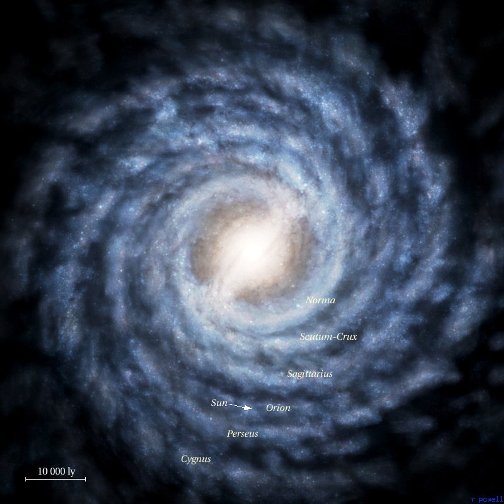
Our galaxy – the Milky Way, a
merkavah (chariot) temple of the Elohim. (YehezqEl
(Ezek.) 1:16)
We may perceive the Tetragrammaton in the night sky because
the turning earth orbits the sun to which she is attracted, and because there
is an intergalactic affinity that holds our entire solar system (including the
earth), and all the mazalot which we see as “fixed”, in greater orbits about
the veiled galactic lobe. Thus the Ahmehstrahans connected
the Tetragrammaton
in the firmament, with the earth, her cyclic seasons, and the cosmic
centripetal affinities that influence her. As mentioned, one of these
affinities is the “power of attraction” resulting in the current standard of time we call a “year” (noted in
Abraham Facsimile 2, Figure 1
explanation).
Notice how the explanation to Figure 1 is worded:
“...the measure of time of this earth, which is called by the Egyptians [Ahmehstrahans] Jah..[Tetragrammaton].”
Might this not also be interpreted to mean that “Jah..[Tetragrammaton]”
became the name of an Ahmehstrahan “measure of time” equal to the time it takes for
“this earth” (under the governance of solar attraction and orbital law) to
cycle through all four seasonal asterisms spelling out the divine name? In other
words, one “Jah..[Tetragrammaton]” is
equal to one earth-year.
The revelation that the orbiting body (mazalah, translated “planet”)
above the earth “moveth in order more slow
... because it standeth above the earth” doesn’t have to be interpreted as
connoting a geocentric universe.
Words like these could have been used to communicate to Abram the principle
that an orbiting body, further away from a central gravitational body,
has reduced orbital speed, and therefore in one
sense a “longer time” standard.
(Abraham 3:5-10)
The statement that the orbiting “lesser light ... reckoning of
its time is not so many as to its number of days” is true for earth’s
satellite, the moon.
(Abraham 3:7)
One lunar day is a month. It is not true in the case of the
outer Jovian planets.
These large planets rotate on their axes faster than the earth. The principle is true in regards to the annual orbits (years) of these planets,
which are considerably longer than an earth
year.
The Ahmehstrahans of Ptolemaic times could have been mindful of the
prophecy in YirmeYahu
(Jer.) 44:26,
Jeremiah 44:26 (KJV),
Jeremias LI.26 (Septuagint). In the Greek
translation of Hebrew scripture, “kurios”, meaning “Lord”, is substituted for the sacred
Tetragrammaton.
The Ahmehstrahans may have thought it wise, in their day, to not fully
pronounce the sacred name
(the Tetragrammaton)
identifying the Hebrew Deity. Instead they preserved a pronunciation
of his name, by associating the name with
“the measurement of time of this earth” under the attractive influence of “Enish-go-on-dosh”, the orbiting star we call “the sun”. They may have
thought it appropriate that an Egyptian word for “earth”, “yah.t”,
sounds similar to a
shortened form of the divine name.
(Michael D. Rhodes,
“The Joseph Smith Hypocephalus ... Twenty Years Later”,
pg. 8) It is true that an Egyptian hieroglyph for “land, earth”,  (Gardiner's N16)
takes part in the Egyptian word for eternity. We may thus perceive a
connection with the sacred name of
the Eternal. Qohelet
(Eccl.) 1:4.
(Gardiner's N16)
takes part in the Egyptian word for eternity. We may thus perceive a
connection with the sacred name of
the Eternal. Qohelet
(Eccl.) 1:4.
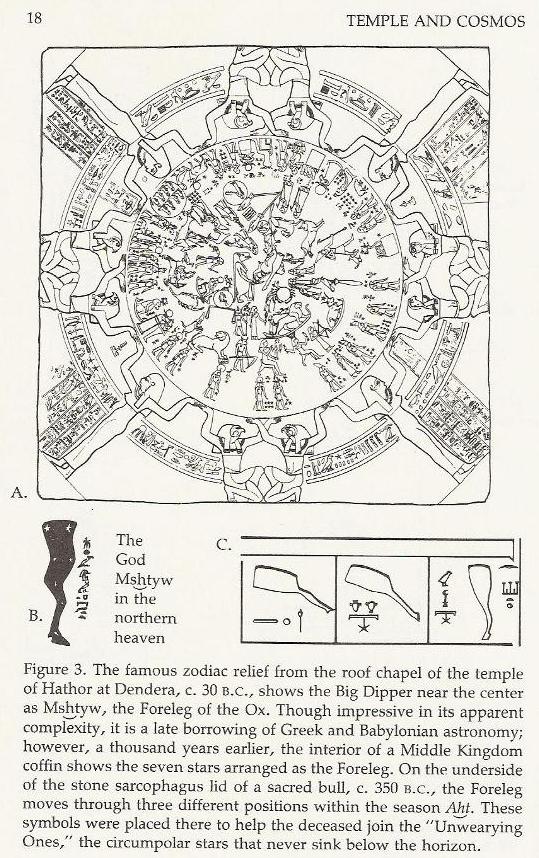
From Professor Hugh Nibley’s Temple and Cosmos, pg 18. The
circumpolar and zodiacal heavens represented on the not so
ancient ceiling of the Dendera Temple of Egypt. The illusory center of the “turning”
heavens is near the well known
circumpolar constellation the “Great Bear” or “Big Dipper”.
The Egyptians perceived this conspicuous constellations as the “Foreleg”.
Familiar constellations of the Greek/Babylonian Zodiac are also featured on
the temple ceiling. For instance, you may notice a lion, a bull, a water
carrier (Hapi son of Horus) with a fish near his foot, and a scorpion. All
of these can be seen in their respective quarters of the heavenly circle.
Associated with each of these seasonal constellations is a
“Royal Star”. These four stars are known to us as Regulus, Antares, Fomalhaut, and
Aldebaran.

In one of the four quarters of heaven
(Dendera Temple ceiling), Hapi son of Horus (filling in as Aquarius) pours water upon Pisces Austrinus (the Southern Fish) which is associated with the Royal Star we
call Fomalhaut.
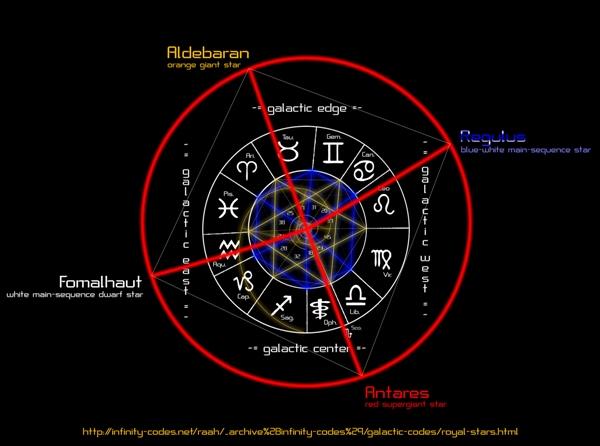
The creator of the Infinity Codes website
has come to a similar realization regarding
the “Royal Stars” and galactic coordinates.
The Book of Iyov (Job) and Ahmehstrahan Constellations
31
Canst thou bind the sweet influences of Pleiades, or loose the bands of
Orion?
32
Canst thou bring forth Mazzaroth in his season?
or canst thou guide Arcturus with his sons?
33
Knowest thou the ordinances of heaven?
canst thou set the dominion thereof in the earth?
(Job 38:31 – 33, KJV)
Here is another translation:
Canst thou bind the chains of
the Pleiades, or loosen the cords of Orion? canst thou bring forth Mazzarot
in their season? or canst thou
guide the Bear with his sons? knowest thou the ordinances of heaven?
canst thou establish its dominion in the earth?
(Iyyov/Job
38:31 – 33, KOREN Jerusalem Bible)
%2038%20verse%2031-33.JPG)
Verse
31
literally reads “Wilt
thou bind the bands* of Kimah or the cords of Kesil let loose?”
*[Brown-Driver-Briggs-Gesenius
Hebrew and English Lexicon,
4575
מַעֲדַנוֹת, pg. 772]
“Kimah” (כִּימָה) is translated “Pleiades”. (Iyov
(Job) 9:9; 38:31) Others
think “Kimah” could be the star “Sirius”.
“Kesil” (כְּסִיל) implies “stupid fellow”, “dullard”, “fool”. The
constellation of Kesil the foolish giant, is usually associated with Orion.
The bound giant of the winter night calls to mind the condemned giant
offspring of the watchers (fallen benei Elohim) described in the book of
Hanokh (Enoch), and briefly mentioned in Bereshit
(Genesis). (See
also
Jude 1:6,
13) In one sense therefore Kesil may have been seen as a
symbol of divine punishment. (LDS Doctrine and Covenants 19:8-12)
The Egyptians saw in the constellation of Orion, Osiris, Lord and prisoner of the underworld. (Rhodes, Books of the Dead Belonging to Tshemmin and Neferirnub, Appendix C, pg. 110.
See also Yesha’Yahu
(Is.) 10:4;
24:22;
42:7;
THE NEW BROWN-DRIVER-BRIGGS-GESENIUS HEBREW-ARAMAIC LEXICON,
631
אׇסַר, pg. 63;
616
אַסׅיר, pg. 64)

Not exactly identical to Orion, let us imagine Kesil’s outstretched red hand (Aldebaran)
reaching for the
ecliptic. Truly a giant
in the sky! (Amos 5:8)
Yesha’Yahu indicates that in the heavens there is more than one giant, there are “khesilim”. (Yesha’Yahu
(Is.) 13:10, “khesilei-hem” is vaguely translated
“constellations thereof” in the KJV) There are
two proposed Ahmehstrahan khesilim (zodiacal giants in the sky), each
associated with a “Watcher” that happens to be a supergiant star. One of these
sky bound giants is in the direction of the
galactic rim. The other,
nearly 180º opposite, is in the direction of the galaxy’s fiery hub - veiled from view by nebular curtains.
The khesilim somewhat resemble the letter “H”, the sound they signify - as in
“Heaven” or “Hell”. Indeed, one giant can be thought
of as a symbol of “everlasting
burnings” (Yesha’Yahu
(Is.)
33:14) in the presence of the galactic center. The other Kesil prefigures “outer darkness” (B’sorot Matti
(Matt.) 22:13) beyond the
galactic rim. This calls to mind the Ahmehstrahan term
“Hahdees”, as in the inglorious kingdom of darkness
“Dah tu Hah dees”.
Amazingly, this esoteric name, revealed by Joseph Smith, evinces a familiarity with both the Egyptian
“Duat”, and Greek
“Hades” concepts.
(Luke 16:22-26)
Iyyov/Job
38:32
reads “Wilt thou bring forth Mazar[l]ot [mazalot –
misspelled in scripture] in his time? And Aish with her sons (baneyah)
wilt thou lead?”
But there are curious problems with this Hebrew verse. The
Koren translation reads “Mazzarot in
their season”,
which makes sense since “mazalot”
is feminine plural. But the Hebrew clearly
reads “b’ito” = “in his time” not “their season”. The Ahmehstrahans
may have recognized in this verse reference to the seasonal mazalot
coming forth in “his time”,
the Eternal’s time – spelling out the
divine name. The mazalot therefore are zodiacal constellations near
the ecliptic. These are constellations that appear at “set times”, unlike
circumpolar constellations which are ever present to view in the clear night
sky. (Abraham 3:10)
Verse 32 goes on to mention “Aish”
(עַיִשׁ) or “Iyush” (עִיֻשׁ) translated “the Bear”.
Could the name be related in to “Y'ush” (יְעוּשׁ) = “He comes
(hastens) to help (lend aid)”? The
letter “yod” in this astronomical name is missing in Iyov
(Job)
9:9. Others presume that “Aish” is a star like “Arcturus” (KJV), a carryover from the Latin Vulgate translation.
“Aish”
appears to be in a different stellar category from the “mazalot”, because “Aish” is most likely a circumpolar constellation
(as is the Great
Bear); whereas the “mazalot” are seasonal or zodiacal.
The Hebrew verse appears to read
“And Aish (עַיִשׁ) with her sons
(בּניה) …” But what is it about “Aish” (עַיִשׁ) that makes the name feminine, justifying the inclination to interpret
בּניה as
“her sons”? Both the KJV and the
Koren translations read “his sons”.
What if the Ahmehstrahans saw
this verse differently? What if they read “Iyush with the son(s)
of Yah [ben-Yah, or bene-Yah] wilt thou guide?”
To the Ahmehstrahans “bene- Yah” (בּניה)
could have called to mind “sons of God(s)”, the “benei Elohim” previously mentioned in
the same chapter. (Iyov
(Job) 38:7)
If “Aish” is a
she-bear, where in the night sky do
we find her “sons”? There is an Ursa Minor, but
what “sons” (plural) were associated with the Ursa Major?
Jewish Astronomers thought of the trailing stars Alioth, Mizar and Alkaid as
cubs following their mother “Aish”. The Egyptians, however, did not
perceive the constellation as a “bear” or a “dipper”. Doubtless the Ahmehstrahans
would have correlated the “bene-Yah” (the “benei Elohim” of the book of Iyov)
with the sons of the sky god
Horus, who were already
associated with the
notable circumpolar constellation in Egyptian mythology.

The Sons of Horus depicted upside down in the
netherworld portion of the
Joseph Smith Book of the Dead Hypocephalus
adapted as Abraham Facsimile 2
(see Figure 6). The explanation given is: “Represents the earth
in its four quarters.” The Sons of Horus were also associated with the
four stars
forming “the cup” of the asterism
westerners call “the Big Dipper”. This prominent asterism is helpful in dividing the night sky into
quarters. Each quarter has
its bright “Royal Star” near the
ecliptic (the apparent
pathway of the sun). It just so happens that the four “Royal Stars” or
“Watchers” are near locations in the night sky that help coordinate the earth
with the galaxy.
Verse 33
literally reads: “Knowest
thou the ordinances of heaven(s)?
Wilt thou establish his [the
Eternal’s] rule
in the earth?”
This verse can be interpreted to mean that the symbolic, yet
physical ordinances presented in the heavens, correlate with the Eternal’s
governance on earth.
The Ahmehstrahans could have concluded
from this verse, that what was written in the heavens pertained to (blessed
or threatened) the
earth. The ordinances of the heavens were seen as uniquely tied to earth’s
endowments - for instance, her
seasons. So in their minds, the name written in the heavens became the earth’s.
Consider YirmeYahu
(Jer.) 33:16.
The letter hey at the end of Hebrew words is often
considered a feminine ending.
One can choose to think of the
hey at the end the earth’s divine name as denoting a feminine name.
Ordinances of Heaven(s)
Here is how you can locate
each constellation of the Ahmehstrahan Tetragrammaton
(with their attendant Royal Stars or Watchers)
using the Sons of Horus
as guides:
Find the four stars (Sons of
Horus) that form “the cup” of the Big Dipper (Great Bear). If it is springtime,
and the evening sky is clear, the sides and bottom of “the cup” will point
directly to an asterism that looks like a
forearm (palm open, thumb extended). An imaginary line from the edge of
“the cup” closest to “the handle” will lead your eyes directly to the bright star forming the “elbow”.
This is the Zoroastrian Watcher “Venant”; which westerners call “Regulus”.
If it is autumn, an imaginary
ray from the other side of the “the cup” (Sons of Horus), arcing across
the night sky in the opposite direction, will land your eyes on a circlet of
stars by the side of a great “square” of stars. This circlet forms the “head of
a nail”.
(Ezra 9:8,
Yesha’Yahu (Is.) 22:25)
The bright “point of the nail” (southward) is the Watcher “Haftorang” or “Hastorang”.
This star also goes by the name “Fomalhaut”.
The conspicuous giants with
upraised hands (the “khesilim”) are roughly orthogonal (90 degrees) on the
ecliptic with respect to the
“hand” and “nail” asterisms. The Khesilim are both near “the Milky Way”, but at opposite ends. One giant looms near
the Orion arm of the galaxy, the other near the Sagittarian arm (see Our galaxy
above). These arms appear blended
together (from the earth) as “the broad white road in heaven, Pathway of the ghosts, the
shadows” (Song of Hiawatha).
Thus the sons of the sky god,
and the “the Milky Way”, can help define the quarters of
the night sky. You will have to be patient to see all the signs, in their set times as the seasons roll on.
Beyond these directions, you
may want to obtain a planisphere
for the mid-north latitudes, and seek clear night skies free from light pollution (away from any big city).
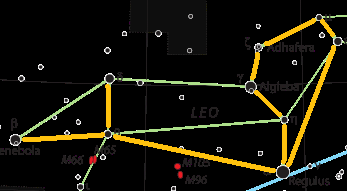
The “hand” ,
“forearm of spring” or “yad
ha-aviv”
(outlined in gold/yellow). This constellation appeared high in the ancient springtime sky of the Northern
Hemisphere, at evening. The first of the year, according to the lunar-solar calendar
revealed by
the
Eternal
to Mosheh (Moses) and Aharon (Aaron), begins in the spring with harvestable barley
-
in the
month of the aviv. (Shemot
(Ex.) 12:1-2) The children of
Yisra’El
(Israel) did not
rely on this constellation to set the year, but doubtless noticed its
seasonal appearance, and dominance. The bright, blue-white
Royal Star we
call Regulus (actually a
multiple star system) forms the elbow of the arm. What appears to the
unaided eye to be a single bright star is actually more than one star in orbital
union. Here we may see an an analogy to the unity of the Elohim.
What is singular from one point of view, is a plurality from another. Regulus is seen near the
ecliptic
(blue line) – apparent pathway of
the sun, near the pathways of the moon and planets. Regulus is the brightest star in the pagan
constellation of Leo the lion (partially outlined in green). Regulus, in the
constellation of the “yad of spring”, begins the
spelling of the divine name in earth’s starry firmament. ,
“forearm of spring” or “yad
ha-aviv”
(outlined in gold/yellow). This constellation appeared high in the ancient springtime sky of the Northern
Hemisphere, at evening. The first of the year, according to the lunar-solar calendar
revealed by
the
Eternal
to Mosheh (Moses) and Aharon (Aaron), begins in the spring with harvestable barley
-
in the
month of the aviv. (Shemot
(Ex.) 12:1-2) The children of
Yisra’El
(Israel) did not
rely on this constellation to set the year, but doubtless noticed its
seasonal appearance, and dominance. The bright, blue-white
Royal Star we
call Regulus (actually a
multiple star system) forms the elbow of the arm. What appears to the
unaided eye to be a single bright star is actually more than one star in orbital
union. Here we may see an an analogy to the unity of the Elohim.
What is singular from one point of view, is a plurality from another. Regulus is seen near the
ecliptic
(blue line) – apparent pathway of
the sun, near the pathways of the moon and planets. Regulus is the brightest star in the pagan
constellation of Leo the lion (partially outlined in green). Regulus, in the
constellation of the “yad of spring”, begins the
spelling of the divine name in earth’s starry firmament.
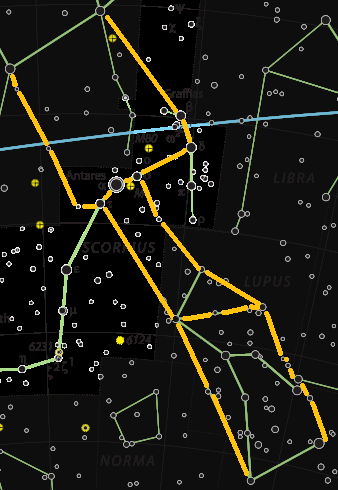
The first “upraised arms” ,
“giant of summer” or “kesil qayits” is
outlined in gold/yellow. This proposed Ahmehstrahan constellation became
dominant in
the ancient night sky of the Northern Hemispheres towards summer (qayits).
The bright Royal Star near the head (or heart) is the red supergiant
Antares.
Called by the Magi “Satevis”, and by the Arabs “Kalb al Aqrab”, “Heart of the Scorpian”, Antares appears near the ecliptic (blue line). Red Antares is the brightest
star in the pagan constellation Scorpius (partially outlined in green).
The Egyptians
associated the scorpion with Isis,
sister/spouse of Osiris. One may perceive in the extended Ahmehstrahan
constellation, her tress of long hair (saarah). The Ahmehstrahan asterism includes stars from the nearby pagan
constellation of Ophiuchus the serpent-bearer (also partially outlined in green).
Two stars of Ophiuchus form the upraised hands of the giant. The giant’s
body and legs include stars from the lower constellation of Lupus the wolf
(outlined in green). As seen from the earth, the “hey of summer” situates
in the general direction of the unseen, blazing mount of our galaxy. The
veiled center of the galactic temple is in the general direction of the
nearby teapot shaped constellation Sagittarius (the archer). Shielding the
earth from the super radiant galactic center are curtains (arms) of nebular
material – like the veils of a great temple. Our universe is ablaze with forms of radiation which the human eye cannot see.
(Tehilim (Ps.)
139:11-12) We know of the super radiant center of our galactic home via infrared and x-ray telescopy,
and by viewing the structures of similar far off galaxies.
The veiled
center houses “the eldest of all the stars, the greatest body of the heavenly bodies...”
known to us. (Grammar and Alphabet of the Egyptian
Language (1835), Second Part, 1st Degree, Kolob,
pp. 32,
34) ,
“giant of summer” or “kesil qayits” is
outlined in gold/yellow. This proposed Ahmehstrahan constellation became
dominant in
the ancient night sky of the Northern Hemispheres towards summer (qayits).
The bright Royal Star near the head (or heart) is the red supergiant
Antares.
Called by the Magi “Satevis”, and by the Arabs “Kalb al Aqrab”, “Heart of the Scorpian”, Antares appears near the ecliptic (blue line). Red Antares is the brightest
star in the pagan constellation Scorpius (partially outlined in green).
The Egyptians
associated the scorpion with Isis,
sister/spouse of Osiris. One may perceive in the extended Ahmehstrahan
constellation, her tress of long hair (saarah). The Ahmehstrahan asterism includes stars from the nearby pagan
constellation of Ophiuchus the serpent-bearer (also partially outlined in green).
Two stars of Ophiuchus form the upraised hands of the giant. The giant’s
body and legs include stars from the lower constellation of Lupus the wolf
(outlined in green). As seen from the earth, the “hey of summer” situates
in the general direction of the unseen, blazing mount of our galaxy. The
veiled center of the galactic temple is in the general direction of the
nearby teapot shaped constellation Sagittarius (the archer). Shielding the
earth from the super radiant galactic center are curtains (arms) of nebular
material – like the veils of a great temple. Our universe is ablaze with forms of radiation which the human eye cannot see.
(Tehilim (Ps.)
139:11-12) We know of the super radiant center of our galactic home via infrared and x-ray telescopy,
and by viewing the structures of similar far off galaxies.
The veiled
center houses “the eldest of all the stars, the greatest body of the heavenly bodies...”
known to us. (Grammar and Alphabet of the Egyptian
Language (1835), Second Part, 1st Degree, Kolob,
pp. 32,
34)

The “vav” ,
“nail of the living streams” or “vav
ha-etanim” is outlined above in
gold/yellow. This proposed Ahmehstrahan constellation could be seen in the
ancient night sky of the Northern Hemispheres near the time of ingathering
and harvest. The head of the nail is the circlet of stars (a Pisces fish,
partially outlined in green) beneath the great square (Pegasus). The shaft
of the nail is formed by stars that are part of the pagan constellation of
the water bearing (Hapi son of Horus, or Aquarius – partially outlined in
green). The shaft of the nail runs more or less parallel to water poured out
by Hapi. The ancient Hebrew season of the etanim,
during which this constellation would regularly appear, seems rather appropriate.
The point of the nail is the bright Royal Star we call
Fomalhaut –
appearing at the mouth of the southern fish (Pisces Austrinus). The bright
star (actually a triple star) is surrounded by circumstellar debris –
appearing telescopically as if it were
blood surrounding the point of a nail. ,
“nail of the living streams” or “vav
ha-etanim” is outlined above in
gold/yellow. This proposed Ahmehstrahan constellation could be seen in the
ancient night sky of the Northern Hemispheres near the time of ingathering
and harvest. The head of the nail is the circlet of stars (a Pisces fish,
partially outlined in green) beneath the great square (Pegasus). The shaft
of the nail is formed by stars that are part of the pagan constellation of
the water bearing (Hapi son of Horus, or Aquarius – partially outlined in
green). The shaft of the nail runs more or less parallel to water poured out
by Hapi. The ancient Hebrew season of the etanim,
during which this constellation would regularly appear, seems rather appropriate.
The point of the nail is the bright Royal Star we call
Fomalhaut –
appearing at the mouth of the southern fish (Pisces Austrinus). The bright
star (actually a triple star) is surrounded by circumstellar debris –
appearing telescopically as if it were
blood surrounding the point of a nail.
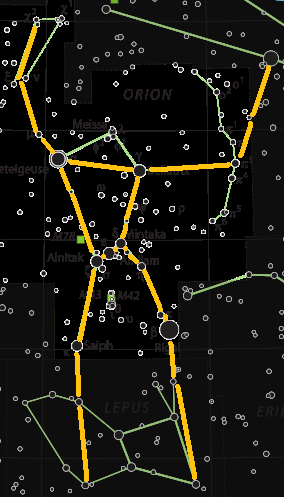
The last “upraised arms” ,
“giant of winter” or “kesil horeph” is outlined in gold/yellow.
This proposed Ahmehstrahan constellation arrived in the ancient night sky of
the Northern Hemispheres towards winter (horeph). The bright
Royal Star forming a
raised palm of the giant, is the reddish-orange supergiant
Aldebaran.
Called by the Magi “Tascheter”, Aldebaran appears near the ecliptic (not shown in the image above).
Aldebaran is the brightest star in the pagan constellation Taurus the bull
(partially outlined in green). The proposed Ahmehstrahan constellation
however, is largely composed of stars associated with the constellation of
Orion (partially outlined in green). Relative to the earth, the “giant of
winter” is bound to that part of the sky that is in the direction of the
outer limits of the galaxy – literally “outer darkness”. In the opposite
direction from bound Kesil, is the veiled celestial center of the galactic
temple. ,
“giant of winter” or “kesil horeph” is outlined in gold/yellow.
This proposed Ahmehstrahan constellation arrived in the ancient night sky of
the Northern Hemispheres towards winter (horeph). The bright
Royal Star forming a
raised palm of the giant, is the reddish-orange supergiant
Aldebaran.
Called by the Magi “Tascheter”, Aldebaran appears near the ecliptic (not shown in the image above).
Aldebaran is the brightest star in the pagan constellation Taurus the bull
(partially outlined in green). The proposed Ahmehstrahan constellation
however, is largely composed of stars associated with the constellation of
Orion (partially outlined in green). Relative to the earth, the “giant of
winter” is bound to that part of the sky that is in the direction of the
outer limits of the galaxy – literally “outer darkness”. In the opposite
direction from bound Kesil, is the veiled celestial center of the galactic
temple.

Back to
Abraham in Egypt and the Papyrus Solar
Ferry
To
Esoteric Egyptian in the Margins of the Book of Abraham
To
Joseph Smith’s
Book of the Dead Hypocephalus
On to
Esoteric Egyptian in Facsimile No. 2
See also
Ahmehstrahan
Counting and Gematria

Hebrew sense is preserved when read on Internet Explorer - e.g. below, my name in Hebrew should read right!
Vincent Coon
וִינְסֶנט כּוּן
© Copyright 2016
|
|








